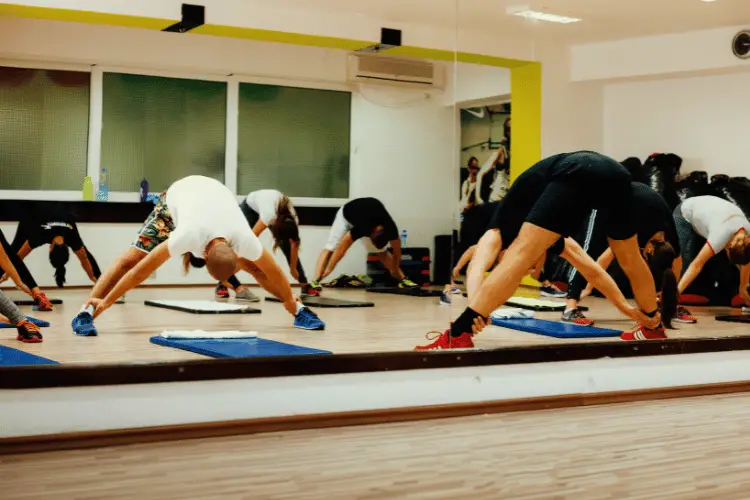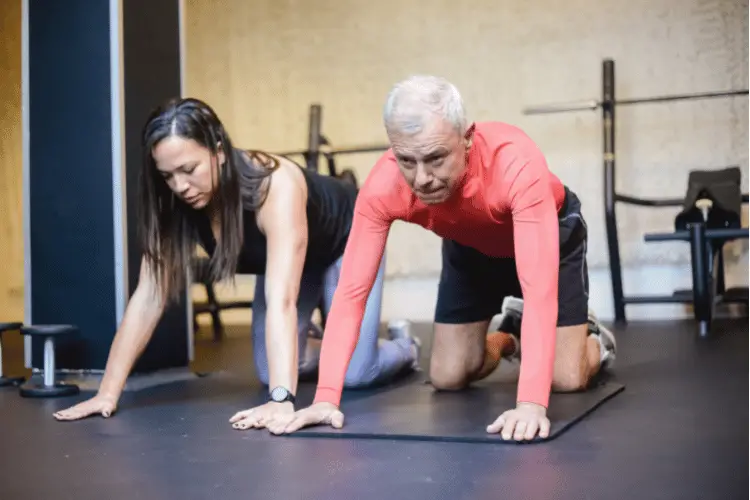You might’ve heard about HIIT from your gym buddies or seen a few fitness influencers promoting it, but what exactly is it?
HIIT, or High-Intensity Interval Training, is a shortened exercise regimen that focuses on keeping your heart rate up and your muscles working hard.
Big, important piece of information here: Intensity is absolutely correlated with results. That’s why this training method is popular and that’s why it works.
Read on to learn facts about HIIT and how it can benefit you.

What is High-Intensity Interval Training (HIIT)
HIIT training promises the same physical endurance and fat burning as longer interval training sessions. The kicker is that it squeezes all the regular interval training to around half an hour. HIIT’s prime aim is to push your heart rate to 80% of its maximum rate.
It involves several high-intensity workout movements with breaks in between and integrates multiple rounds. Each round can last anywhere between ten seconds to eight minutes, depending on each session’s style.
HIIT centers around aerobic and resistance movements. After the intense exercises, the workout follows short periods of lower-intensity ones. Alternatively, the intervals can follow a rest period. These are part of the recovery phase of HIIT.
One of the best parts about HIIT is that you don’t usually require equipment. Most of the training uses your body as the top form of resistance. Additionally, the training can be completed in relatively small spaces, making them ideal for home workouts.
How Long Do HIIT Workouts Last?
HIIT workouts last between 20 to 45 minutes.
It involves keeping your heart rate up. As a good rule of thumb, you know you’re doing a HIIT workout if you’re so out of breath that you can barely get any words out.
In terms of rounds, professionals usually recommend a ratio of 1:1. In other words, a 60-second workout should follow a 60-second rest period. If you’re still new to HIIT, you can increase your work-to-recovery phase ratio to 1:3. Meanwhile, athletes can go as high as a 3:1 ratio (60 seconds of work, 20 seconds of rest).
There’s no shortage of exercise options for HIIT workouts. Check out some of them below to familiarize yourself with what to expect during training.
Exercises in HIIT
- Burpees
- Jumping Jacks
- High Knees
- Mountain Climbers
- Push-Ups
- Rope Jumping
- Lunge Jumps
- Russian Twists
- Skaters
- And every abdominal exercise in the book
HIIT can include several variations of the mentioned exercises to cater to beginners. Alternatively, some variations are tailored to advanced trainers and amp up the intensity with weights or more resistance.
Advantages of HIIT Training
There are multiple benefits you can gain from this type of training. From calorie burning to improving stamina, you’ll get a lot out of those 20 to 30-minute workouts.
HIIT Burns More Calories
Long slow distance training typically keeps your heart rate stable and your body burns calories at a slower rate. You can expect much more calorie-burning with HIIT training.
It gets better. You don’t only shed calories during the HIIT workout but after it as well. After the grueling movements, your body continues burning more calories for a period of time. This phenomenon is called excess post-exercise oxygen consumption (EPOC).
You Can Integrate HIIT Into Your Favorite Activities
Working out isn’t everyone’s cup of tea, especially HIIT. For this reason, you can integrate your favorite activity with intense training intervals. You can apply it to your dancing, running, rowing, or biking sessions.
HIIT is Versatile
Aside from that, HIIT is also exceptionally versatile. People of all physical levels can practice the intense workout at tailored intervals. You can generally choose between types of HIIT, like Tabata, cardio, or weights.
Tabata is well-suited for beginners and advanced HIIT participants. It involves multiple exercises split into eight rounds, divided into 20-second work and 10-second rest intervals. The workout can range from lunges and squats to crunches and high knees. It is named “Tabata” after a Japanese scientist who studied interval training.
Studies concurred on the effectiveness of Tabata since it enhances your body’s anaerobic capacity and VO2 max. Research involving HIIT biking participants saw a 15% increase in VO2 max after exercising five days a week for six weeks.
Meanwhile, cardio HIIT emphasizes the steady increase of your heart rate. If you have a heart condition, I suggest treading lightly and consulting your doctor. The exercises in cardio HIIT target your glutes, quadriceps, core, and hamstrings.
Although most HIIT workouts don’t need equipment, you can increase the intensity by adding weights. It’ll help you bulk up on muscle and pump your resistance. That said, you can get creative with the weight items. Try using a weight vest or ankle or wrist weights.
HIIT Enhances Your Metabolic Rate

One study suggests that HIIT can increase fat oxidation levels after a workout. Subsequently, it uses fats for energy expenditure rather than carbohydrates.
Since HIIT allows you to burn calories post-workout, your body’s metabolic rate significantly increases in those hours compared to your normal basal metabolic rate. The HIIT regimen has better chances of upping your metabolism than traditional weight training or jogging.
HIIT Increases Your Muscle Mass
Increasing muscle mass may not automatically mean you have to hit the weights or get your bar reps in. While this may seem too good to be true, it can be for most people. Some lucky people out there can gain muscle solely from HIIT workouts.
On this, it really depends on where you are coming from. A bodybuilder or someone who’s already into weight training isn’t going to see any muscle increase from HIIT workouts.
But if you are predominantly a jogger or cyclist, you may see some muscles show up where before they weren’t present.
If you were sedentary before or not really working out, you will see the most gain in muscle.
HIIT Improves Heart Health
HIIT’s health benefits extend to your cardiovascular system. The workout is proven to decrease resting heart rate and blood pressure among the obese and overweight population.
According to a reputable study, a HIIT routine of three times per week for 20 minutes equates to an endurance training routine of four times per week for 30 minutes. The workouts produce similar results in terms of toning down blood pressure.
These studies are exclusive to overweight people, and according to that data, HIIT workouts don’t significantly alter the blood pressure and heart rate of average-weighted individuals.
HIIT Delays Aging
Research in HIIT found the cellular effects of the well-revered workout. It turns out that it increases protein levels in your cell’s mitochondria, which is known as the powerhouse of the cell.
The cells’ proteins typically degenerate over time. Now, these muscle cells can be the ones in your brain or heart. Aside from that, HIIT releases nerve-protecting proteins called brain-derived neurotrophic factor (BDNF).
Subsequently, it enhances your brain’s plasticity or ability to make new connections, which leads to better memory and learning.
Safety Precautions for HIIT
Before embarking on a HIIT routine, you should know the safety risks associated with the intense regimen. Check out some of them below.
Understand Your Fitness Level
Understanding your fitness level is the most critical point worth considering before adding HIIT to your routine. If you’re still new to the training, opt for a beginner’s ratio interval and HIIT workout.
HIIT workouts require a significant amount of endurance and stamina. Despite that, research stipulates that it’s not as mind-numbing as other moderate-intensity workouts. HIIT exercises produce painkilling endorphins.
Aside from that, if you’re new to HIIT, start slow and learn how to apply proper form to each exercise. A personal trainer would be ideal in this situation. It would even be worth your time to spend your first training session just learning the moves and not actually getting that much of a workout.
Additionally, be sure to warm up before you workout.
You can use a 30 second-work 60-second-recovery interval and use 75% effort during your first sessions.
Consider Your Injuries

If you have a medical condition, you may need professional supervision. You need to let your trainer know of any pre-existing conditions so they can plan your routine accordingly.
Besides heart issues, if you have diabetes or retinopathy, you might need to consult your doctor. Nevertheless, researchers conducted a study on football players with the latter complication. After six weeks, with three days of HIIT, the players reaped positive results.
Dress Appropriately
While training, be sure to wear form-fitting clothing. It’ll help enhance your mobility, especially during exercises like mountain climbers and bear crawls.
Plus, wear shoes that provide a full range of ankle motion. We suggest opting for cross-trainers. You can also ask your trainer for recommendations.
Wrap-Up
Whether you’re looking to challenge yourself or just want to cut down your training time, HIIT workouts are your best bet.
HIIT comes with a ton of benefits and whether or not you want to make it your primary form of exercise, at least try it out and get a feel for it. You won’t be disappointed.
References
- https://www.hsph.harvard.edu/nutritionsource/high-intensity-interval-training/
- https://www.everyoneactive.com/content-hub/fitness/what-is-hiit-training-benefits-exercises/
- https://www.shape.com/fitness/tips/how-long-should-hiit-intervals-be-study
- https://www.sciencefocus.com/the-human-body/hiit-is-changing-the-way-we-workout-heres-the-science-why-it-works/
- https://www.healthifyme.com/blog/10-best-hiit-cardio-workout-for-weight-loss/
- https://www.americansportandfitness.com/blogs/fitness-blog/5-safety-considerations-for-hiit-workouts
- https://www.vox.com/science-and-health/2019/1/10/18148463/high-intensity-interval-training-hiit-orangetheory
- https://www.ncbi.nlm.nih.gov/pmc/articles/PMC8544043/
- https://bjsm.bmj.com/content/51/6/494
- https://fitbod.me/blog/should-you-do-hiit-every-day/



